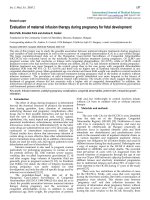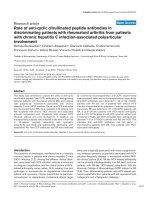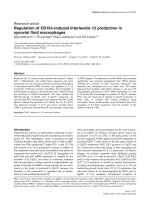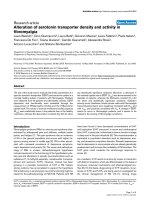Báo cáo y học: " Evaluation of Lumbar Facet Joint Nerve Blocks in Managing Chronic Low Back Pain: A Randomized, Double-Blind, Controlled Trial with a 2-Year Follow-U"
Bạn đang xem bản rút gọn của tài liệu. Xem và tải ngay bản đầy đủ của tài liệu tại đây (543.52 KB, 12 trang )
Int. J. Med. Sci. 2010, 7
124
I
I
n
n
t
t
e
e
r
r
n
n
a
a
t
t
i
i
o
o
n
n
a
a
l
l
J
J
o
o
u
u
r
r
n
n
a
a
l
l
o
o
f
f
M
M
e
e
d
d
i
i
c
c
a
a
l
l
S
S
c
c
i
i
e
e
n
n
c
c
e
e
s
s
2010; 7(3):124-135
© Ivyspring International Publisher. All rights reserved
Research Paper
Evaluation of Lumbar Facet Joint Nerve Blocks in Managing Chronic Low
Back Pain: A Randomized, Double-Blind, Controlled Trial with a 2-Year
Follow-Up
Laxmaiah Manchikanti
1
, Vijay Singh
2
, Frank J.E. Falco
3
, Kimberly A. Cash
4
, Vidyasagar Pampati
5
1. Medical Director of the Pain Management Center of Paducah, Paducah, KY and Associate Clinical Professor, Anest-
hesiology and Perioperative Medicine, University of Louisville, Louisville, KY, USA
2. Medical Director, Pain Diagnostics Associates, Niagara, WI, USA
3. Medical Director of the Mid Atlantic Spine & Pain Physicians of Newark, DE; Director, Pain Medicine Fellowship, Tem-
ple University Hospital, Philadelphia, PA, Associate Professor, Department of PM&R, Temple University Medical School,
Philadelphia, PA, USA
4. Research Coordinator at the Pain Management Center of Paducah, Paducah, KY, USA
5. Statistician at the Pain Management Center of Paducah, Paducah, KY, USA
Corresponding author: Laxmaiah Manchikanti, MD, 2831 Lone Oak Road, Paducah, Kentucky 42003. Phone:
270-554-8373; Fax: 270-554-8987; E-mail:
Received: 2010.03.24; Accepted: 2010.05.26; Published: 2010.05.28
Abstract
Study Design: A randomized, double-blind, controlled trial.
Objective: To determine the clinical effectiveness of therapeutic lumbar facet joint nerve
blocks with or without steroids in managing chronic low back pain of facet joint origin.
Summary of Background Data: Lumbar facet joints have been shown as the source of
chronic pain in 21% to 41% of low back patients with an average prevalence of 31% utilizing
controlled comparative local anesthetic blocks. Intraarticular injections, medial branch blocks,
and radiofrequency neurotomy of lumbar facet joint nerves have been described in the al-
leviation of chronic low back pain of facet joint origin.
Methods: The study included 120 patients with 60 patients in each group with local anes-
thetic alone or local anesthetic and steroids. The inclusion criteria was based upon a positive
response to diagnostic controlled, comparative local anesthetic lumbar facet joint blocks.
Outcome measures included the numeric rating scale (NRS), Oswestry Disability Index
(ODI), opioid intake, and work status, at baseline, 3, 6, 12, 18, and 24 months.
Results: Significant improvement with significant pain relief of ≥ 50% and functional im-
provement of ≥ 40% were observed in 85% in Group 1, and 90% in Group II, at 2-year fol-
low-up.
The patients in the study experienced significant pain relief for 82 to 84 weeks of 104 weeks,
requiring approximately 5 to 6 treatments with an average relief of 19 weeks per episode of
treatment.
Conclusions: Therapeutic lumbar facet joint nerve blocks, with or without steroids, may
provide a management option for chronic function-limiting low back pain of facet joint origin.
Key words: Chronic low back pain, lumbar facet or zygapophysial joint pain, facet joint nerve or
medial branch blocks, comparative controlled local anesthetic blocks, therapeutic lumbar facet joint
nerve blocks
Int. J. Med. Sci. 2010, 7
125
Introduction
Recent investigations
1
have reported the rising
prevalence of chronic low back pain. Freburger et al
1
showed an increasing prevalence of chronic impairing
low back pain over a 14-year interval from 3.9% in
1992 to 10.2% in 2006 – an overall increase in the pre-
valence of low back pain of 162% with an annual in-
crease of 11.6%. The widely held belief that most of
the episodes of low back pain will be short-lived, with
80% to 90% of these attacks resolving in about 6
weeks,
2,3
has been questioned.
1,4-8
Multiple structures in the lumbar spine includ-
ing discs, facet joints, and sacroiliac joints have been
considered the major sources of pain in the low back
and/or lower extremities. Lumbar facet joints have
been implicated as the source of chronic pain in 21%
to 41% (with an overall prevalence of 31%) in a hete-
rogenous population with chronic low back pain
9-18
utilizing controlled comparative local anesthetic
blocks with 80% pain relief and the ability to perform
previously painful movements as the criterion stan-
dard. Further, based on the responses to controlled
diagnostic blocks, false-positive rates of 17% to 19%
have been established with an overall false-positive
rate of 30%.
9-14,16-18
Datta et al
9
established Level I or
II-1 evidence for the diagnostic accuracy of controlled
facet joint nerve blocks based on the United States
Preventive Services Task Force (USPSTF) criteria.
19
In
addition, Rubinstein and van Tulder
20
concluded that
there is strong evidence for the diagnostic accuracy of
lumbar facet joint blocks in evaluating low back pain.
Significant controversy surrounds the appropri-
ate management of lumbar facet joint pain, with mul-
tiple therapeutic techniques established in managing
chronic low back pain.
9,10,21-23
The systematic review
by Datta et al
9
provided Level III (limited) evidence
for lumbar intraarticular injections,
24,25
Level II-1 evi-
dence for lumbar facet joint nerve blocks,
26-28
and
Level II-2 evidence for lumbar radiofrequency neu-
rotomy.
29-31
The exact mechanism of the therapeutic
effect of lumbar facet joint nerve blocks is not known,
whereas radiofrequency neurotomy causes denatur-
ing of the nerves. Consequently, with radiofrequency
the pain returns when the axons regenerate requiring
repetition of the radiofrequency procedure. Similarly,
lumbar facet joint nerve blocks may be repeated to
reinstate pain relief without any deleterious effects.
The basis for intraarticular injections has been the
inflammation of the joint.
This report consists of the 2-year results of the
comparativeness of lumbar facet joint nerve blocks
with or without steroids evaluated in a randomized,
double-blind, controlled trial in patients with a con-
firmed diagnosis of lumbar facet joint pain by means
of comparative, controlled, local anesthetic blocks
based on modified International Association for the
Study of Pain (IASP) criteria, with 80% pain relief and
ability to perform previously painful movements.
9-11,32
Materials and Methods
The study was conducted at an interventional
pain management practice, a specialty referral center,
in a private practice setting in the United States. The
study was performed based on Consolidated Stan-
dards of Reporting Trials (CONSORT) guidelines.
33,34
The study protocol was approved by the Institutional
Review Board (IRB) and the study has been registered
with the clinical trial registry as NCT00355914.
Participants
One hundred twenty patients were assigned to
one of the 2 groups consisting of either a non-steroid
group (Group I) or a steroid group (Group II). Both
groups were also divided into 2 categories each with
the addition of Sarapin. Both groups received bupi-
vacaine with or without steroid, however, category B
patients also received Sarapin in both groups. All
mixtures consisted of clear solutions. Bupivacaine and
Sarapin were mixed in equal volumes, and 0.15 mg of
non-particulate betamethasone was added per mL of
solution.
Inclusion and Exclusion Criteria
Inclusion criteria consisted of those patients
with a history of chronic function-limiting low back
pain of at least 6 months duration, 18 years of age,
who were able to provide voluntary informed con-
sent, willing to participate in the study as well as the
follow-up, with positive results to controlled diag-
nostic lumbar facet joint nerve blocks with at least
80% concordant pain relief and the ability to perform
previously painful movements.
For diagnostic lumbar facet joint interventions
the exclusion criteria included radicular pain, surgical
interventions of the lumbar spine within the last 3
months, uncontrolled major depression or psychiatric
disorders, heavy opioid usage (morphine equivalent
of 300 mg), acute or uncontrolled medical illness,
chronic severe conditions that could interfere with the
interpretations of the outcome assessments, women
who were pregnant or lactating, patients unable to be
positioned in the prone position, and patients with a
history of adverse reactions to local anesthetic, Sara-
pin, or steroids.
Int. J. Med. Sci. 2010, 7
126
Interventions
All of the patients were provided with the in-
formed consent and protocol approved by the IRB,
which described the details of the trial including side
effects and the mechanisms of withdrawal from the
study.
Diagnostic Lumbar Facet Joint Nerve Blocks
All patients included in the study underwent
controlled comparative local anesthetic blocks with
0.5 mL of 1% preservative-free lidocaine, followed by
0.5 mL of 0.25% bupivacaine on a separate occasion,
usually 3 to 4 weeks after the first injection, if the re-
sults of the lidocaine block were positive. All of the
procedures were performed in a sterile operating
room, with intermittent fluoroscopic visualization,
with intravenous access, and light sedation with mi-
dazolam being offered to all patients. A response was
considered positive if there was 80% pain relief of at
least 2 hours for lidocaine and 3 hours for bupivacaine
and greater than the duration of relief with lidocaine,
and the ability to perform multiple maneuvers which
were painful prior to the diagnostic facet joint blocks.
All other types of responses were considered nega-
tive; however, the diagnostic phase was not part of
the study.
Therapeutic Lumbar Facet Joint Nerve Blocks
In the therapeutic phase, patients were treated
with lumbar facet joint nerve blocks under fluoros-
copy in a sterile operating room with the injection of a
0.5 to 1.5 mL mixture at each level as assigned by
grouping.
Additional Interventions
Patients were followed at 3-month intervals un-
less otherwise indicated and lumbar facet joint nerve
blocks were repeated based on the response to the
prior interventions with improvement in physical and
functional status. Lumbar facet joint nerve blocks
were repeated only when the reported pain levels
deteriorated to below 50%, with initial report of sig-
nificant pain relief of 50% or more after the previous
block. The non-responsive patients receiving other
types of treatments after stopping therapeutic lumbar
facet joint nerve blocks were considered to be with-
drawn from the study, and no subsequent data were
collected.
Co-Interventions
All patients were provided with the same
co-interventions as needed with opioid and
non-opioid analgesics, adjuvant analgesics, and pre-
viously directed exercise programs prior to enroll-
ment in the study. The adjustments in medical thera-
py were carried out based on the response to injection
therapy and physical and functional needs. However,
no specific co-interventions such as physical therapy
or occupational therapy were provided.
Objective
The objective of this randomized, double-blind,
controlled trial is to determine the clinical effective-
ness of therapeutic lumbar facet joint nerve blocks
with local anesthetic with or without steroids in
managing chronic low back pain of facet joint origin.
Outcomes
Outcome measures included the numeric rating
scale (NRS), Oswestry Disability Index 2.0 (ODI),
employment status, and opioid intake, with assess-
ment at 3, 6, 12, 18, and 24 months post-treatment.
NRS represented 0 with no pain and 10 with the
worst pain imaginable. The ODI was utilized for
functional assessment. Value, validity, and frequent
usage have been reported.
33,35-42
Significant pain relief was described as a 50% or
more reduction in the NRS score, and significant im-
provement in function was described as at least a 40%
reduction in ODI.
Opioid intake was evaluated based on the do-
sage frequency and schedule of the drug, with con-
version of opioid intake into morphine equivalents.
43
Patients unemployed or employed on a
part-time basis with limited or no employment due to
pain were classified as employable. Patients who
chose not to work, were retired, or were homemakers
(not working, but not due to pain) were not consi-
dered in the employment pool.
Sample Size
For this evaluation, a sample size of 60 patients
for each group was chosen. There were no rando-
mized trials available to base the calculation of sample
size. Further, the sample size was much smaller in
previous studies of lumbar
44
and cervical
45
medial
branch neurotomies. The literature evaluating the
quality of individual articles has shown a sample size
of 50 patients in the smallest group as acceptable.
46
Randomization
Sixty patients were randomly assigned into each
group from a total of 120 patients. Among each group,
30 patients were assigned to each category for Sara-
pin.
Sequence Generation
Randomization was carried out in blocks of 20
patients by a computer-generated random allocations
sequence.
Int. J. Med. Sci. 2010, 7
127
Allocation Concealment
Patients were randomized and the drugs were
prepared appropriately by the operating room nurse
assisting with the procedure. All drug mixtures ap-
peared to be identical.
Implementation
After the patients had met the inclusion criteria
one of the 3 nurses assigned as coordinators of the
study enrolled the participants and assigned partici-
pants to their respective groups. All the patients were
invited to enroll in the study if they met inclusion
criteria.
Blinding
The random allocation was not revealed to per-
sonnel in the recovery room or to the physician per-
forming the procedure. Study patients were mixed
with other patients with no specific indication that
patients were participating in the study.
Patients were unblinded if they requested to be
unblinded or after completing 24 months of the study.
Patients were provided with an opportunity to dis-
continue or withdraw from the study for lack of pain
relief or for any other reason. All the patients with loss
of follow-up were considered to be withdrawn.
Statistical Methods
Chi-squared statistic, Fisher’s exact test, paired
t-test, and one-way analysis of variance were used to
analyze the data.
Chi-squared statistic was used to test the dif-
ferences in proportions. Fisher’s exact test was used
wherever the expected value was less than 5; a paired
t-test was used to compare the pre- and
post-treatment results of average pain scores and the
ODI measurements at baseline versus 3, 6, 12, 18, and
24 months. The t-test was performed for comparison
of mean scores between groups. One-way analysis of
variance was used for comparison of means among
groups.
Initially, categories with or without Sarapin in
each group were analyzed by comparing them to each
other. Subsequently, local anesthetic and steroid
group were compared if there were no differences.
Intent-to-Treat-Analysis
An intent-to-treat-analysis was performed on all
patients utilizing the last follow-up data. Initial data
were utilized in the patients who dropped out of the
study without further follow-up after the first treat-
ment. Sensitivity analysis was performed utilizing
best case, worst case, and last follow-up scores scena-
rios.
Results
Participant Flow
Figure 1 illustrates the participant flow.
Recruitment
The recruitment period lasted from November
2003 to July 2006.
Baseline Data
Demographic characteristics are illustrated in
Table 1. There were significant differences between
Group I and II with respect to height with Group II
patients taller than Group I patients. This is not ex-
pected to change the outcomes.
The number of joints involved was as follows: 2
joints were involved in 70% of the patients and 3 joints
were involved in 30% of the patients. Bilateral in-
volvement was seen in 79% of the patients.
Table 1. Demographic characteristics.
Group I
(local anesthetic
without steroids)
(N = 60)
Group II
(local anesthetic
with steroids)
(N = 60)
Gender Male 35% (21) 45% (27)
Female 65% (39) 55% (33)
Age Mean ±
SD
48 ± 15 46 ± 17
Height (inch-
es)
Mean ±
SD
66 ± 3.8 68* ± 4.1
Weight
(pounds)
Mean ±
SD
183 ± 48 189 ± 50
Duration of
pain (months)
Mean ±
SD
108 ± 102 108 ± 94
Mode of onset
of pain
Gradual 52% (31) 62% (37)
Sudden 16% (10) 5% (3)
WC/MVA 32% (19) 33% (20)
H/O of pre-
vious lumbar
surgery
20% (112) 13% (8)
Group I = bupivacaine with or without Sarapin
Group II = bupivacaine and steroids with or without Sarapin
WC = Workers compensation
MVA = Motor vehicle injury
Analysis of Data
Numbers Analyzed
Data were analyzed for both categories in each
group to evaluate the influence of Sarapin. There were
no significant differences. Thus, descriptions are pro-
vided for the 2 groups with local anesthetic with or
without steroid.
Figure 1 illustrates details of patient follow-up
and intent-to-treat analysis.
Int. J. Med. Sc
Fig. 1. Schem
Missing Data
A sensi
pain scale w
score, best c
shown in T
a
ences; hence
low-up visit
ci. 2010, 7
matic presentat
itivity analys
was perform
ase scenario,
able 2. There
e, intention-to
was utilized.
ion of patient f
sis with chan
med utilizing
and worst c
e were no sig
o-treat analys
flow at 2-years
nges in nume
last follow-u
case scenario
gnificant diffe
is with last f
s follow-up.
eric
up
as
er-
ol-
Outco
Pain Re
N
ble 3.
from
b
groups
2 year
omes
elief
Numeric pain
There were s
baseline, at 3,
s, with no diff
rs, the propo
n scale scores
significant ch
6, 12, 18, and
ferences amon
ortion of pati
http://www.m
are illustrate
hanges in pai
d 24 months i
ng Groups I a
ients with si
medsci.org
128
ed in Ta-
in scores
in all the
and II. At
gnificant









